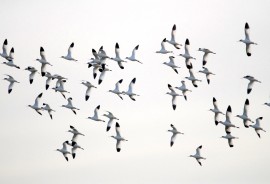
Bird surveys and mitigation, including those for wind farms, are an important part of our work.
Our experienced ornithologists can advise on, and conduct, all aspects of breeding bird surveys, impact assessment, and mitigation. Our expert team at The Ecology Consultancy regularly reports on, and surveys, wild birds and their breeding and wintering habitats.
Around 400 species of bird have been recorded in the UK. These consist of resident birds, which both breed and overwinter in the UK; migrants - both summer and winter visitors; and those species that occur on passage. Birds occur in both rural and urban areas.
All wild birds, their nests and young are protected throughout England and Wales by the Wildlife & Countryside Act 1981 (as amended). It is illegal to kill, injure or take any wild bird, or damage or destroy the nest or eggs of breeding birds. The legislation applies to all bird species, common and rare. In addition to the protection afforded to all wild birds, rarer or particularly vulnerable species listed on Schedule 1 of the 1981 Act, such as the barn owl, receive enhanced protection when breeding. Schedule 1 species, including their dependent young, are protected from intentional or reckless disturbance whilst at or near the nest, in addition to the protection afforded the more common species.
If nests, whether completed or in the process of being built, are found on site, any works with the potential to damage or destroy the nest, eggs or young birds, must stop until the birds have completed breeding. This includes any activity that could potentially cause an adult bird to desert the nest resulting in death or egg failure. Nesting sites should be inspected only by experienced ecologists.
Any disturbance of a breeding Schedule 1 bird is an offence, regardless of whether this impacts upon the breeding attempt. These nests can only be visited by an ecologist with a licence for the specific species concerned.
Birds may nest on machinery or scaffolding and other temporary site structures. If this happens the equipment cannot be used until the birds have finished nesting and such areas may need to be sealed off to prevent disturbance.
Breaking the law can lead to fines of up to £5000 per offence and potential prison sentences of up to six months. Vehicles implicated in an offence can be compounded and both the company, and/or the individual(s) concerned, can be held liable.
Our consultants offer specialist breeding bird surveys, including breeding and wintering bird surveys, surveys for breeding birds of prey, and vantage point surveys.
We also advise on and implement mitigation measures such as installing boxes (e.g. swift boxes) for nesting birds, and provide training and research services.
Projects we have worked on include:
Different species show different preferences as to where they nest. Some species are predominantly scrub or ground-nesting, others favour trees. Several species such as swifts and swallows have adapted to nesting in or on buildings, and other man-made structures.
Birds in the UK typically build their nests and lay their eggs between March and the end of August. The peak months for breeding are May and June. However, there are exceptions to this, such as the collared dove, which nest all year round, and species such as the barn owl that may also breed over a longer period. Therefore, it is possible that birds may be found breeding on a construction site at unexpected times of the year.
Breeding bird surveys are best conducted in suitable habitat with a methodology based on the BTO Breeding Bird Survey (BBS). A site is visited on a minimum of four occasions, each visit commencing at dawn, to record the numbers and species present.
Survey time: March to August
Ecology Surveys, Mitigation, and ECoW for the onshore elements of the Galloper… read more
 Bird surveys for windfarm development in Norfolk read more
Bird surveys for windfarm development in Norfolk read more
 Ecological Impact Assessment for A14 Road Improvement, Cambridgeshire read more
Ecological Impact Assessment for A14 Road Improvement, Cambridgeshire read more
 Code for Sustainable Homes, Hayward’s Heath, East Sussex read more
Code for Sustainable Homes, Hayward’s Heath, East Sussex read more
 Ecological planning, The Fat Walk, London read more
Ecological planning, The Fat Walk, London read more
 Restoration of historic farm ponds, Norfolk read more
Restoration of historic farm ponds, Norfolk read more
 Ecological planning at Leamouth Peninsular read more
Ecological planning at Leamouth Peninsular read more
 Norfolk Breeding Bird and Bat Survey - Little Snoring read more
Norfolk Breeding Bird and Bat Survey - Little Snoring read more
Our returning peregrines are choosing concrete over cliffs read more
 RTVi (Russian International Television) interview on wind farms and their impact on… read more
RTVi (Russian International Television) interview on wind farms and their impact on… read more
 RSPB corncrake reintroduction project read more
RSPB corncrake reintroduction project read more
 Site X: bespoke mitigation and habitat enhancement programme at DP World London… read more
Site X: bespoke mitigation and habitat enhancement programme at DP World London… read more
 Late nesting of barn owls could delay projects again this year read more
Late nesting of barn owls could delay projects again this year read more
'“TEC have been working on our wind farm project since 2010. Although I joined the project more recently, I am impressed with the range of ecological services they have provided over the years, including a delicate translocation project for reptiles, and working closely with Natural England to develop a satisfactory bat licence. Galloper Wind Farm […]'
© The Ecology Consultancy, part of The Temple Group.
Created by COR.


